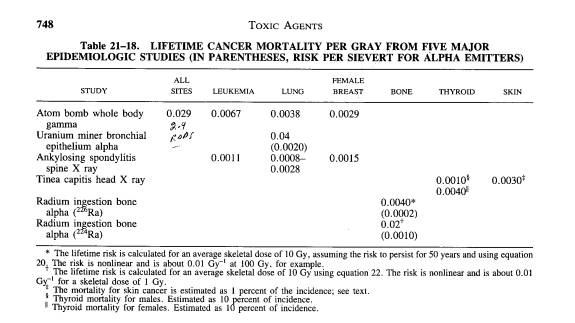
Radiation
While this course focuses on the health effects of chemicals, the effects of radiation, especially the inhalation of radioactive particles, is an important part of toxicology and the kinds of issues we are likely to be involved in. Here is a site from a different course. It covers the basics of ionizing and non-ionizing radiation from the worker safety aspects. After you have perused that, come back here for more on the mechanism of toxicity.[You will need go back to your ENVE 652 bookmark to return here.] Intro to ionizing and non-ionizing radiation.
Toxic Effects of non-ionizing radiation
Ultraviolet Light (UV) An excellent discussion of the mechanism of UV and Skin Cancer.
Electromagnetic (EM) radiation
Of course it is possible to get burns from high power EM radiation. The
effects of low power electromagnetic radiation, especially its carcinogenicity,
is only slightly less controversial than endocrine disrupters. Unlike those,
I feel comfortable discussing low power EM. Briefly, the only damage from low
dose EM is tissue heating. So getting inside a microwave oven is not a good
idea. Standing beside one is not harmful, or at least I do it. Likewise, talking
on your cell phone while driving 60 mph on an icy road is a very bad idea, but
it does not cause brain, or any other type, of cancer. But, here's someone else's
opinion on that subject. Recently, I found millions of hits on "cell phones" and "cancer."
Ionizing radiation
Ionizing radiation of sufficient power is capable of breaking the chemical bonds in DNA and breaking DNA strands. Here the issue is how much radiation is administered. Here is a Table © from Casarett and Doull's that relates the amount of radiation in Grays (one Gray = 100 RADs, that is, radiation energy that is absorbed). You'll note that it is fairly consistent, for the most part within an order of magnitude. Compare that with LD50s that range over 8 orders of magnitude

The likely mechanism is that the radiation produces free radicals, especially the potent hydroxyl radical. These react with DNA, proteins and lipids. The rapidly dividing cell types (blood cell-forming areas of bone marrow, gastrointestinal tract lining) are the most affected by ionizing radiation and the severity of the effects depends upon the dose received. Depending on the amount of damage, the cell can be killed outright or DNA damage might persist in a living cell. Some of the damage types are:
-breaks in one or both DNA strands (can lead to rearrangements, deletions,
chromosome loss, cell death if unrepaired; this is from stimulation of recombination)
-damage to/loss of bases (mutations)
-crosslinking of DNA to itself or proteins
Now some history: The genetic effects of radiation were reported in 1927 in Drosophila by Muller and in 1928 in plants (barley) by Stadler; both showed that the frequency of induced mutations is a function of X-ray dose. Their experiments revealed that there was a linear relationship between X-ray dose and induced mutation level. This implies that there was no threshold or "safe" dose of radiation and that all doses are significant. Finally, "split dose" experiments showed that the genetic effects of radiation are cumulative.[That's from http://www-personal.ksu.edu/~bethmont/mutdes.html#mutagens ] This leads to the conclusion that there is no safe dose of radiation. Lower doses may cause less mutations. Is that true? If the cells die, there is no problem - that is why x-rays are used in medical treatments to "burn" tumors. Discounting that, might there be a safe dose? If cells repair DNA damage, and we are sure they do, there should be a dose, below which virtually all the damage is repaired. Here is an excellent web review of the human epidemiology. Wilson. It appears to me that very low doses, below background, are either not harmful or, the harm is too small to be detected.
End of Submodule